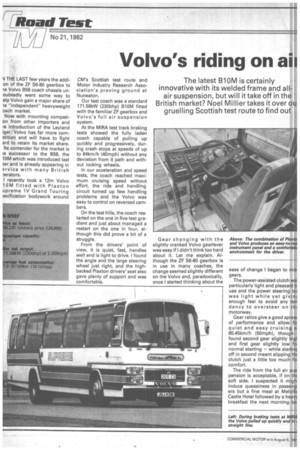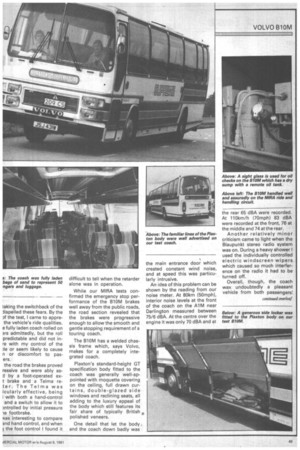Volvo's riding on all
Page 38

Page 39

If you've noticed an error in this article please click here to report it so we can fix it.
The latest BlOM is certainly innovative with its welded frame and allair suspension, but will it take off in the British market? Noel Millier takes it over ou gruelling Scottish test route to find out
■ 1 THE LAST few years the addion of the ZF S6-80 gearbox to le Volvo B58 coach chassis unoubtedly went some way to elp Volvo gain a major share of le "independent" heavyweight pach market.
Now with mounting competion from other importers and le introduction of the Leyland iger, Volvo has far more conietition and will have to fight ard to retain its market share. Its contender for the market is le successor to the B58, the 10M which was introduced last ar and is already appearing in arvice with many British Derators.
I recently took a 12m Volvo 1 OM fitted with Plaxton upreme 1V Grand Touring lecification bodywork around CM'S Scottish test route and Motor Industry Research Association's proving ground at Nuneaton.
Our test coach was a standard 171.58kW (230bhp) B1OM fitted with the familiar ZF gearbox and Volvo's full air suspension system.
At the MIRA test track braking tests showed the fully laden coach capable of pulling up quickly and progressively, during crash stops at speeds of up to 64km/h (40mph) without any deviation from it path and without locking wheels.
In our acceleration and speed tests, the coach reached maximum cruising speed without effort, the ride and handling circuit turned up few handling problems and the Volvo was easy to control on reversed cambers.
On the test hills, the coach restarted on the one in five test gradient and just about managed a restart on the one in four, although this did prove a bit of a struggle.
From the drivers' point of view, it is quiet, fast, handles well and is light to drive. I found the angle and the large steering wheel just right, and the highbacked Plaxton drivers' seat also gave plenty of support and was comfortable. Gear changing with the slightly cranked Volvo gearlever was easy if I didn't think too hard about it. Let me explain. Although the ZF S6-80 gearbox is in use in many coaches, the change seemed slightly different on the Volvo and, paradoxically, once I started thinking about the ease of change I began to mis gears.
The power-assisted clutch we particularly light and pleasant ti use and the power steering tol was light while yet givini enough feel to avoid any ten dancy to oversteer on thl motorway.
Gear ratios give a good sores( of performance and allow fo quiet and easy cruising a 80.45km/h (50mph), though found second gear slightly higl and first gear slightly low fo normal starting — while startinc off in second meant slipping tho clutch just a little too much fo comfort.
The ride from the full air sus pension is acceptable, if on th( soft side. I suspected it migh induce queasiness in passeng ers but a fine meal at Melvill( Castle Hotel followed by a heav) breakfast the next morning be taking the switchback of the iispelled these fears. By the Df the test, I came to apprethe vehicle's ride qualities. e fully laden coach rolled on 3rs admittedly, but the roll predictable and did not inre with my control of the :le or seem likely to cause n or discomfort to pasors.
the road the brakes proved ressive and were ably asI by a foot-operated ox brake and a Telma reter. The Telma was icularly effective, being I with both a hand-control and a switch to allow it to )ntrolled by initial pressure ie footbrake.
vas interesting to compare 3nd hand control, and when the foot control I found it difficult to tell when the retarder alone was in operation.
While our MIRA tests confirmed the emergency stop performance of the B1OM brakes well away from the public roads, the road section revealed that the brakes were progressive enough to allow the smooth and gentle stopping requirement of a touring coach.
The B1OM has a welded chassis frame which, says Volvo, makes for a completely integrated coach.
Plaxton's standard-height GT specification body fitted to the coach was generally well-appointed with moquette covering on the ceiling, full drawn curta n s, double-glazed side windows and reclining seats, all adding to the luxury appeal of the body which still features its fair share of typically British 6, polished veneers.
One detail that let the body , and the coach down badly was the main entrance door which created constant wind noise, and at speed this was particularly intrusive.
An idea of this problem can be shown by the reading from our noise meter. At 80km (50mph), interior noise levels at the front of the coach on the AIM near Darlington measured between 75/6 dBA. At the centre over the engine it was only 70 dBA and at the rear 65 dBA were recorded. At 110km/h (70mph) 83 dBA were recorded at the front, 76 at the middle and 74 at the rear.
Another relatively minor criticism came to light when the Blaupunkt stereo radio system was on. During a heavy shower I used the individually controlled electric windscreen wipers which caused so much ihterferonce on the radio it had to be turned off.
Overall, though, the coach wax undoubtedly a pleasant vehicle from both passengers' contmued overleaf














































